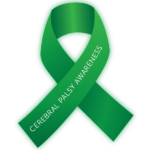What is Cerebral palsy (CP)?
Cerebral palsy (CP) is a life-long condition that affects muscle movement and coordination. In the United States about 10,000 babies born each year will have this condition. “Cerebral” refers to the brain and “palsy” means weak muscles.
What causes Cerebral palsy (CP)?
CP happens as a result of injury to the brain while it is still developing, usually before, during, or soon after birth. However, the injury that happens to the brain does not get worse over time.
What are the symptoms of Cerebral palsy (CP)?
CP can affect people differently depending on what muscles in the body are involved. For example, the muscles in one or both arms and/or legs can be affected or the whole body can be. Muscles may be stiff or spastic, or sometimes floppy. Some people with CP are able to walk, while others need crutches or a wheelchair. Some may have trouble writing or feeding themselves, while others do not. There can be a variety of other conditions connected with CP, such as seizure disorders and learning disabilities. Although having CP can be challenging, most people with CP can have a healthy and active life and be successful in school and in the workplace.
Are there different types of Cerebral palsy (CP)?
Yes. The most common type is “spastic” CP, which can affect certain muscles in a person’s body such as the legs but it can also affect the arms. For someone with spastic CP, walking may be difficult because the muscles are very stiff. If one side of the body is affected, it is called “spastic hemiplegia/hemiparesis.” Spastic quadriplegia or quadriparesis affects both arms and legs and is considered the most serious type of CP since most people who have it must use a wheelchair. They may also have other challenges such as: vision, speech hearing, and learning problems. Other types include “dyskinetic” CP which causes uncontrollable movements of arms, hands, legs and feet and “ataxic” CP which causes problems with balance. A person can have more than one type of CP.
Is there a cure for Cerebral palsy (CP)?
Right now there is no cure for CP; however, science is always moving forward. Many research studies are looking at both risk factors and prevention to lower the risk of someone being born with CP.
What is the treatment for Cerebral palsy (CP)?
Since CP affects people differently, treatment varies depending on a person’s needs. Although the injury to the brain cannot be healed, there are ways to manage limitations. The main goal in treating someone with CP is to help them achieve quality of life by providing adaptive equipment to increase mobility and help them become as independent as possible.
I have a sibling, friend, classmate or partner with Cerebral palsy (CP). How can I be supportive?
Understanding CP will help you be supportive to a person who is living with this condition. Support might include asking them how you can be helpful so they can participate in activities at school or letting them know you are there to talk to about CP or anything else. Since everyone copes differently, the best way to know what someone needs is to ask!
Additional Resources:
https://www.cerebralpalsy.org.au/services/for-teenagers/
 Young Men's Health
Young Men's Health

